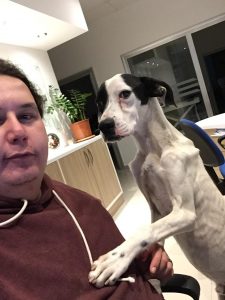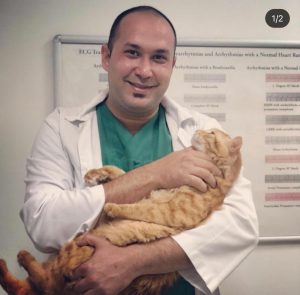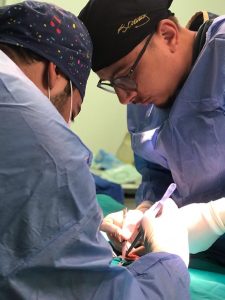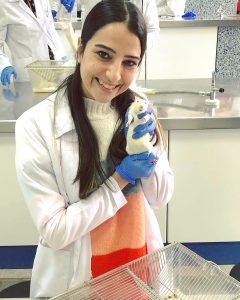Dehorning of Cattle - Res. Asst. Atasel Petin

Cattle horns were once common; they were extensions of the skull used for show, protection, and identifying the herd leader. Nevertheless, with the herd management and care-feeding conditions afforded by contemporary livestock operations, these activities have lost their relevance.
The reasons why horned animals are not wanted in the farm;
- Open wounds from horn blows
- Mastitis (inflammation of the breast tissue) and atrophy of the breast as a result of deep injuries to the breast tissue
- Economic losses due wounds on the hide
- Miscarriages
- Traumas in various tissues
- Etc.
Apart from the impact on the herd, it is advisable to trim or dull the horns since they are harmful to cattle farm workers and other personnel on the farm.
Canine Ehrlichiosis - Res. Asst. Havva Süleymanoğlu

The disease is transmitted by ticks. It is known to be transmitted by the saliva from an infected tick or by blood transfusion from infected dogs. The cause of the disease is a parasite called Erlichia Canis. Primary symptoms of the disease includehigh fever, nosebleed, pale mucosa, depression, loss of appetite and petechiae haemorrhages on the skin. The disease disrupts the structure of the blood, causing damage in the kidneys by spreading throughout the body by means of systemic effect, and can be transmitted to humans. The definitive diagnosis of the disease is made in veterinary laboratorieswith a specific indirect florescent antibodytest (IFA) of the disease. Antibiotics are used for the treatment of the disease. Clinical improvement begins within 24-48 hours in dogs that are treated in the early stages of the disease. Although the disease remains in the body for life, our pet friends can lead a normal life, provided that they are monitored regularly.
Araş. Gör. Havva Süleymanoğlu
Sterilisation (Castration) Operation in Male Animals - Res. Asst. Gökhan Ulukan

Elective surgeries are operations that are recommended for the improvement of conditions that have led to or will lead to the deterioration of your pet’s health. Operations that are not a medical emergency but are highly likely to be life threatening over time are sometimes called semi-elective. Castration, which is the most frequently performed elective/semi-elective surgical procedure in veterinary practice as a solution to the rapid population growth in small animals, is based on the surgical removal of the genital organs called testes or epididymis in male animals.
As well as being solution to the issue of rapid population growth in veterinary medicine, castration is practiced in other areas aswell. In veterinary medicine, castration is also preferred for:the prevention and treatment of diseases such as prostate enlargement related to the male genital hormone in later ages, possible prostate neoplasia, prostate inflammation, perineal and inguinal hernia, the correction of behavioural problems,the prevention of the transmission of endocrine diseases and hereditary illnesses triggered by hormonal changes such as diabetes, controlling epilepsy seizures,the torsion of the spermatic cordfrom which the testicles hand, testes and epididymis inflammation, congenital anomalies of these organs and the correction of undescended testicles with high probability of neoplasia.
The most important thing the pet owner should pay attention to while preparing for a castration operation is to prevent food from being given to the patient 8 hours prior to the procedure, as anaesthesia will be given. Because the stomach muscles relax andthe protective reflexes disappear while under anaesthesia, there is a risk of stomach contents flowing back to the throat and from there to the lungs via the trachea. Therefore, it is necessary to restrict food intake the night before. If the veterinarian deems it appropriate for the patient to be sent home after the castration operation, you should be careful not to allow the patient to run around or lick the surgical site in the first week. If you are unable to prevent this, it is highly recommended that your pet wears a collar until the stitches are removed to prevent self-trauma in sutured wounds and that you carefully apply the antibiotic and analgesic treatment prescribed by your vet.
Res. Asst. Gökhan Ulukan
Diarrhoeain Cats and Dogs - Vet. Surgeon Çağrı Enginer
Diarrhoea is an intestinal problem, which means that the stool develops a watery consistency due to several reasons, causing an increase in the amountand frequency of defecation. Diet related diarrhoeasuch as suddendiet change, spoiled food consumption, raw meat consumption, stress due to poor care conditions, the presence of pathogenic bacteria and parasites in the intestine, viruses that cause bloody diarrhoea in puppies such as parvoviral enteritis, pancreas and liver diseases,and intestinal tumours can allbe causes ofdiarrhoea. Depending on the severity of the diarrhoea, very serious water loss, the animal’s inability to benefit from nutrients due to malabsorption and weight loss can all be seen in animals suffering from diarrhoea. In such cases, diarrhoea that seems ordinary could be fatal for your pet if a veterinarian does not intervene. Regardless of the reason, diarrhoea is a symptom that should be taken seriously, and you should seek help from your vet as soon as possible.
Vet. Surgeon Çağrı Enginer
The Importance of Sterilisation Surgery in Cats and Dogs - Res. Asst. Enver Evci

Many changes have occurred up until today in the domestication process of cats and dogs, including their reproductive cycles. Pets’ desire to mate is purely based on instinct, not on emotions and feelings. Their instincts tell them that they need to reproduce in order to maintain their species through chemical bonds, namely hormones. In the wild, the balance of nature determines how frequently a species reproduces. However, cats and dogs are no longer part of the wild ecosystem; therefore, this basic instinct no longer takes place in the environment, nor in the natural balance that it should. Due to this imbalance, reproductive cycles are no longer controlled by nature. Thus, sterilization operations have become more popular recently.
Sterilization in female cats and dogs is called ovariohysterectomy and sterilization in male cats and dogs is referred to as orchidectomy-castration. The surgical treatments of females are more complex compared to those of males.
With the Sterilization procedure, most of the risks of genital diseases in female cats and dogs are avoided.For example, females are protected from many diseases such as pyometra in the uterus, ovarian cysts (cystic ovary), breast tumours, mammitis, retention secundinarum, vaginitis and urinary prolapse, and males are protected from diseases such as testicular cancer and prostate gland diseases.
It can be said that unneutered stray cats have an approximate lifespan of less than two years, especially for cats that have contact with the outside environment and live on the street. Unneutered male cats are more irritable and fight more. Therefore, they encounter viral and fatal diseases that are transmitted through bite wounds such as FIVmore frequently.
We encounter cases of TVT (Transmissible VenerealTumour) which can be transmitted through mating and sniffing in many unneutered male and female dogs. TVT is the only contagious type of cancer in the world and can be fatal if not treated.
Unneutered cats and dogs are exposed to many accidents as a result of their hormones and sexual impulses during their heat period.In particular,incases such as falling from a height, traffic accidents and attacking eachother observed in our clinic, it was noted that the cats and dogs that were exposed to these accidents were unneutered.
We also eliminate problems that affect our living standards negatively such as screaming in sterilized female cats during their heat period, bleeding during menstruation in dogs, and urine that male cats and dogs leave to mark their territory.
You may want your cat or dog to be neutered after giving birth once, as you may think this is healthier. This is a common misconception because cats and dogs that are neutered before their first heat period or before they’ve fully reached their sexual maturity live healthier and longer. Additionally, a serious decrease occurs in the rate of future testicular cancers and uterine and ovary tumoursin male and females that are neutered at an early stage. It is observed that dogs that are neutered at the right time live an average of 1-3 years longer, and cats 2-5 years longer.
In conclusion, the neutering procedure eliminates very serious issues regarding the animals with whom we share our homes and those that live on the street.
There are differences in opinions regarding sterilization operations in cats and dogs in many regions. While one sideaccepts the necessityof the sterilization procedure and the positive effects it has on the health of our animal friends, the other idea group argues against it, especiallyfor reasons such as maternal instinct,being unable to experience their sexuality and disrupting their nature.The reason for this stems from the bond we establish with our animals. Our pets especially need people to a great extent for a healthy and quality life, and the living conditions of stray animals are often not very good. In general terms, alongside difficulty finding nutrients, traffic accidents and disease outbreaks that occur due to uncontrolled reproduction result in many losses among our little friends.
Dogs can reproduce 15-20 times more than humans, while onaverage, cats can reproduce 45-50 times more. The breeding rate of cats and dogs is so high that it is impossible to provide suitable living conditions for each newborn every year. If this situation cannot be controlled, it will become much harder to prevent and control as the population growth in the future will increase exponentially. When we consider all these factors, it becomes apparent just how essential sterilization operations are.
Sterilization operations are the removal of the ovaries and uterus together in cats and dogs, and the removal of the testiclesof male cats and dogs by surgical intervention under completely sterile conditions. All the other treatment methods (hormonal treatments, implants etc.) used aside from this are non-permanent methods that have side effects. All gynaecological diseases that may occur in the uterus or ovaries after the sterilization operations are prevented. Moreover, studies have determined that the frequency of mammary breast neoplasm cases seenin animals decreased significantly. Side effects of sterilization operations include weight gain, malformation of the skin and fur, and in rare cases, urinary incontinence.
Res. Asst. Enver Evci
Foreign Objects in the Digestive System of Cats and Dogs - Res. Asst. Süleyman Özdemir

Foreign object ingestion in cats and dogs is a situation we frequently encounter, especially in young animals, that requires urgent intervention.
Bones, socks and hair ties are the most common foreign linear objects observed in dogs, while sewing needles and thread are more common in cats.In cases where the patient’s owner recognizes this condition, diagnosis can be made quickly, and treatment can be provided before serious complications occur.
It may take a few hours to several months for clinical symptomsto show in animals that have ingested foreign objects. Clinical symptoms such as constant vomiting, excessive salivation, dry heaving, loss of appetite, restlessness, inability to defecate or less frequent defecation may be seen in patients. The patient’s owner should contact their veterinarian as soon as they recognize these symptoms because in delayed cases, the patient may experience weightloss with vomiting,weakening of body condition and general condition disorder. In addition, ingested foreign objects may lead to oesophagus (gullet), stomach and intestinal blockage, mucosal injury and perforations (ruptures) causing peritonitis (inflammation of the abdominal membrane) and the patient may subsequently go into septic shock and die.
The information that the veterinarians receive from the patient’s owner is very important. Answers to questions such as whether there is a lost toy at home, or whether the patient has swallowed a foreign object before makes it easier for us to make a diagnosis. After receiving the information, a clinical examination of the patient is performed. Following the general examination of our patient, detailed oral examinations are performed. Foreign linear objects like thread can be observed during the oral examination. After the oral examination, the abdomen (abdominal) region of the patient is examined by hand to observe whether the patient reacts due to pain or not. Direct and/or indirect radiography, ultrasonography and endoscopy are usedwhile making a diagnosis.
The structure and localization of the detected foreign object helps us to determine the treatment method. Depending on the structure and location of the object, it is decided whether the object will be removed with medical treatment, surgical intervention or an endoscopy. Medical treatment can be applied for smooth foreign objects that are thought to be able to pass through the intestines using stool softening and lubricating medications, but in this case, the patient should be X-rayed every day, and if it is determined that there is no change in the position of the foreign object for 24 hours, a quick decision should be made about surgical removal. It should notbe forgotten that delayed treatment increases the risk of perforation (puncture).In cases where perforation (puncture) has occurred, immediate surgical treatment is required. The presence of blood in the vomit or stool suggests that the foreign object has caused mucosal ulceration.In the case of severe mucosal injury, the patient must not consume anything for 24-48 hours. Additionally, the animal’s general condition should be monitored, blood tests should be done periodically, and liquid supplements should be given to patients that are notfed orally.The prognosis on foreign object ingestion is good for cases that are uncomplicated and treated early. We need to warn the owner about giving disproportionate bone fragments or toy materials that their pet can swallow or that can endanger their pet’s life.
Res. Asst. Süleyman Özdemir
What Is Anterior Cruciate Ligament Rupture in Dogs and How Is It Diagnosed - Res. Asst. Gökay Yeşilovalı

Anterior cruciate ligament ruptureis acondition that occurs in the knee joints of dogsand occurs in 12.2% of all orthopaedic lesions in dogs.This condition, which has a negative effect on the musculoskeletal system due to the changes that form in the knee as a result of interior cruciate ligament rupture, generally affects young, old, and large dog breeds, and the same disease can be observed in the other knee within a year or two.Just as anterior cruciate ligament rupture can occur in dogs of both sexes, all ages or breeds, it is generally owners of young, active, large breed dogs thatget in contact withthe veterinarian for treatment.
In anterior cruciate ligament rupture lesions, the dog may or may not add partial pressure to its leg and a sudden onset of lameness may be observed.
In cases with intermittent lameness, it is predicted that meniscus damage is also involved in addition to the anterior cruciate ligament rupture lesion and that these cases should be taken to a veterinarian immediately. In dogs with long-term anterior cruciate ligament rupture, long-term lameness is observed when determining that the leg is used and body weight can be carried. Patients may have difficulty while sitting or standing. The dog may be observed sitting with the affected leg away from the body.The limp typically worsens after exercise or sleep.There are several specific methods practiced clinically in the diagnosis of anterior cruciate ligament ruptures. Your veterinarian can use appropriate examination methods and can make a diagnosis and start treatment for your little friend’s health.
If your animal shows signs of complaints of intermittent hind leg lameness and sits with its hind legs away from its body, especially in large breed dogs, it is advised that you seek help from a specialist veterinarian immediately in order to prevent irreversible damage to the joint.
Res. Asst. Gökay Yeşilovalı
Traumatic Eye Injuries Due to Foreign Objects in Cats and Dogs - Res. Asst. Ali Çürükoğlu
Our eyes are the sole organ that helps us to engrave into our memories all the events of our bright world by giving us the ability to see; Undoubtedly, it is one of the organs in need of protection in animals aswell. Our eye organ consists of: the eyeball, the eyelids which protect the eyeball, and its appendaged organelles called conjunctiva. When mentioning about trauma caused by foreign objects, we can list the following as causes of damage of the eyeball and appendaged organs: wall barley, which emerges with the warming of the weather in the summer months when pets are exposed, sawdust, metal particles and plant-derived materials in dogs that are found in factory environments.
Consider the pain and distress in our eyes due to the presence of a grain of sand or an eyelash between the eyelids, the irritation of the eye and surrounding tissues where neural stimulation is high. Animals show three important symptoms of foreign object irritation: Inability to look at alight, squinting of the eyelids, and inflamed or normal lacrimation.
There is a risk of piercing the cornea, as well as the progression of foreign bodies by sinking into the inner surface of the eyelids. If your pet does not want to be touched around the eye due to squinting, eye watering and pain, especially after walking in grassy areas, then you may suspect a foreign body trauma in the eye. In such cases, it is recommended that youconsult your veterinarian as soon as possible.
Depending on the foreign body trauma, treatment options may be medical or operative following the removal of the foreign body. Home care of your patient, in which both medical and operative treatment options are performed, is very important. It should not be forgotten that in addition to the regular administration of prescribed eyedrops, collars worn by the animal to protect the eye from traumas that may occur in the eye promote the success of treatment and provide the most important support.
Res. Asst. Ali Çürükoğlu
Bloat or (GDV) Syndrome in Dogs - Res. Asst. Mehmet Pilli
Gastric Dilatation-Volvulus (GDV),is an emergency syndrome that we can define as the expansion of the stomach by turning around its own axis as a result of the reaction of solid and liquid foods in the stomach with the digestive enzymes that form gas. This syndrome, in which there is a serious circulatory disorder as a result of the occlusion of the vascular system that turns with the stomach, is usually encountered in breeds with very large, deep rib cages. However, it should be noted that it occurs more frequently in Shar Pei than other medium-sized breeds, and Basset Hounds also carry a high risk of GDV, although they are small breeds. It can occur in dogs of any age, but it is observed that it occurs mostly in middle-agedand older animals. It should be kept in mind that the ratio between the depth and width of the rib cage is highly associated with the risk of stomach swelling.
Due to its rapid formation, (GDV) syndrome can result in death and requires early diagnosis. It is at the top of the list of veterinary emergencies and its treatment is performed by surgical intervention.
Breeds such as Great Dane, Saint Bernard, Kangal Shepherd Dog, German Shepherd Dog, Rottweiler, Dobermann, Weimaraner, Irish Setter, Gordon Setter, Shar Pei, Basset Hound, Golden Retriever and Labrador Retriever are in the at-risk group.Observing abdominal bloating or enlargement is one of the important findings to be noticed by the owner, but it can sometimes be difficult to detectstomach swelling in obese and muscular large breed dogs. Rapid heartbeat, difficulty breathing, hunched posture due to pain, stagnation, reluctance to walk, groaning, pallor in the mucous membranes, foaming at the mouth, trying to vomit and restless behaviours are among the findings that patient owners should pay attention to.
In order for owners to protect their animals from this syndrome,feeding several small meals a day instead of a single large meal, avoiding stress during feeding, separating dogs during feeding if there is more than one dog in your home, limiting exercise before and after meals, not using high-grade food containers, not mating with dogs whose first degree relative has this disease are recommended. We advise you to consult a veterinarian as soon as you see swelling in the abdomen, and if you have a dog that eats food fast, we recommended that you get a slow feeder.
Youshould take care of our dog properly and not leave it alone too much. Please note that this disease is also referred to as “unhappy dog disease”.
Res. Asst. Mehmet Pilli
Bite Injuries in Dogs as a Result of Fighting Res. Ass. Gül Çıray Akbaş

Tissue injuries as a result of fighting are very common in veterinary medicine. Bite injuries are noted in small breed dogs, which are generally attacked by large breed dogs. We can observe bite wounds in the neck, chest, abdomen, leg areas, including the skin and the layers underneath. Superficial bite wounds in dogs involved in fights and injuries can always be deceptive and have the potential to be life-threatening, depending on the location of the injury. These types of wounds are also called infected "iceberg" injuries with extensive destruction under the skin.
A dog's oral bacterial flora is always apt to contaminate bite wounds. Because their canine teeth and jaws are so strong, the wounds they inflict can crush, puncture or tear muscles and skin. In addition, even a bite that does not damage the skin can cause trauma to the underlying soft tissues, called closed wounds. Most importantly, bite wounds reaching the chest or abdominal cavity can cause pus to accumulate in these spaces due to bacterial contamination. Bite wounds in the neck area require special care as the area contains blood vessels, nerves, the oesophagus and trachea. Although rare, joint inflammation and bone marrow inflammation are also encountered in bite injuries.
With the spread of bacteria to the surrounding area in bite wounds that are left untreated, abscess, fistula or transformation into a general infection will be inevitable. Your veterinarian will determine what type of treatment is necessary based on the extent of the injuries, your dog's general health, and the location of the wounds. Wounds treated within the first 6 hours after injury have a higher chance of uncomplicated healing. It is normal to give your animal some form of pain reliever, sedative or anaesthetic before the veterinarian begins to assess the extent of the wounds. You will have several duties at home. If your dog's wounds are sealed, you will need to keep the area clean and dry. It is imperative that your pet wears a collar. If the wound has been left open to heal or if a drain has been placed in the wound, you will need to take care to keep the area clean on a regular basis. Dogs involved in a fight may also exhibit aggressive behaviour due to the shock of the incident, aches and pain, and should be treated carefully. To avoid fighting, don't let your dog roam freely because you don't know the temperament of other stray dogs. For this reason, your dogmay also need basic obedience training.
Res.Asst. Gül Çıray Akbaş
Pyometra (Uterus Infection) in Cats and Dogs - Halil Güneş Özturan

It is a condition in which the hormonal and structural state of the uterus changes, the defence system deteriorates and the uterus is filled with pus that occurs as a result of infection caused by bacteria entering the cervix that is open during oestrus(rut) and can sometimes be fatal. There are two types depending on whether the cervix is open or closed. In open pyometra, purulent discharge can be observed from the outside, but not in the closed form.
Causes
- Older cats and dogs (generally 6-8 years old) that are not neutered.
- The oestrus of cats and dogs passes before pregnancy occurs.
- Hormone treatment to suppress oestrus.
Symptoms
- Drinking excess water (Polydipsia) - Frequent urination (Polyuria).
- Loss of appetite - Vomiting.
- Depression - lying on acold floor.
- Yellow/grey or red/brown coloured vaginal discharge with odour.
Diagnosis
The diagnosis of pyometra is usually made using clinical manifestations, laboratory data (blood tests) and visualisation techniques (ultrasonography / x-ray).
Treatment
The purpose of the treatment is to enhance the general condition of the patient and surgically remove the uterus(ovariohysterectomy). In addition, medical treatment can also be applied in patients who have a breeding value and offspring are desired in the future.
Halil Güneş Özturan
Vomiting in Cats and Dogs - Res. Ass. Merve Ertan

Vomiting is the active expulsion of stomach contents, which occurs with gastric contraction. In contrast, clinically we do not consider passive expulsion of the contents of the oesophagus without gagging (without gastric contraction) as vomiting. It is important to distinguish the difference between these two concepts. Vomiting is one of the body’s defence mechanisms. There are many factors that can cause vomiting. If your cat or dog is vomiting, this may be a secondary sign of certain diseases.
Vomiting may occur due to reasons such as eating too fast, infections, excessive herb consumption, post-meal exercise, parasitic conditions and various diseases. If vomiting is continuous or lasts longer than two days, if a foreign object or blood is seen in the content of the vomit, or if it has a foul smell, when different symptoms are observed along with vomiting, a veterinarian should be consulted.
Araş. Gör. Merve Ertan